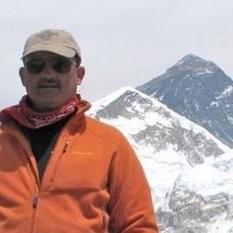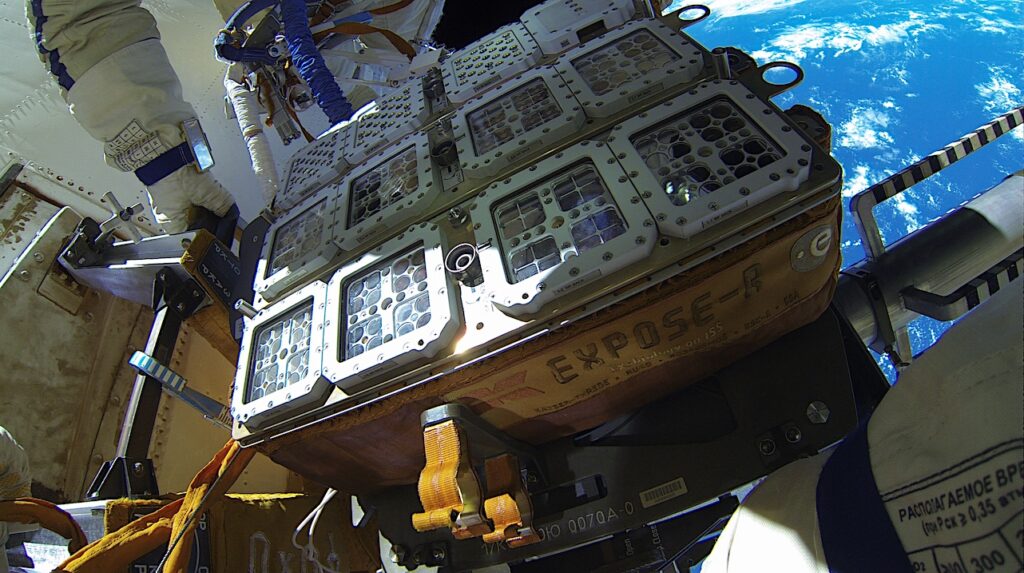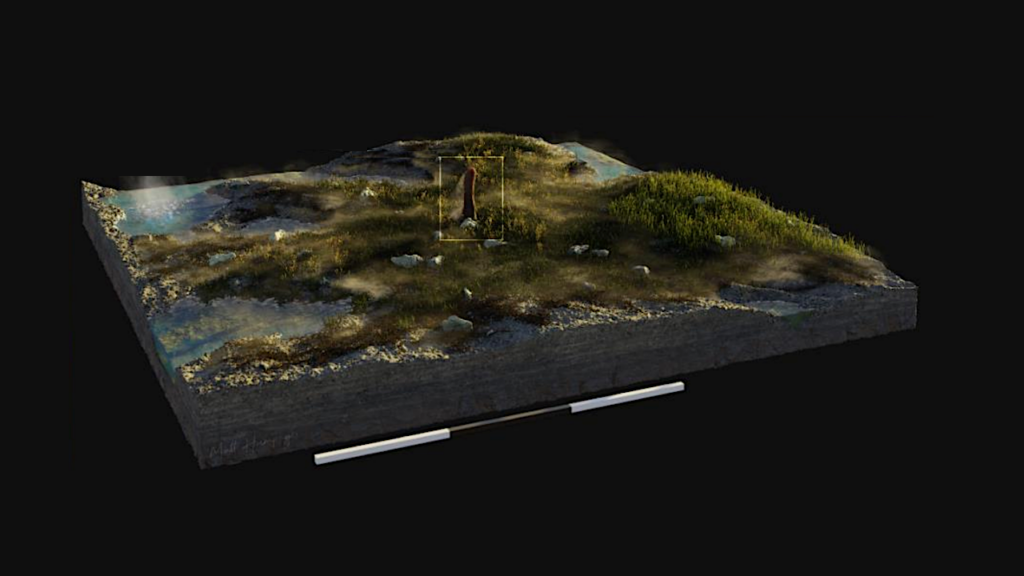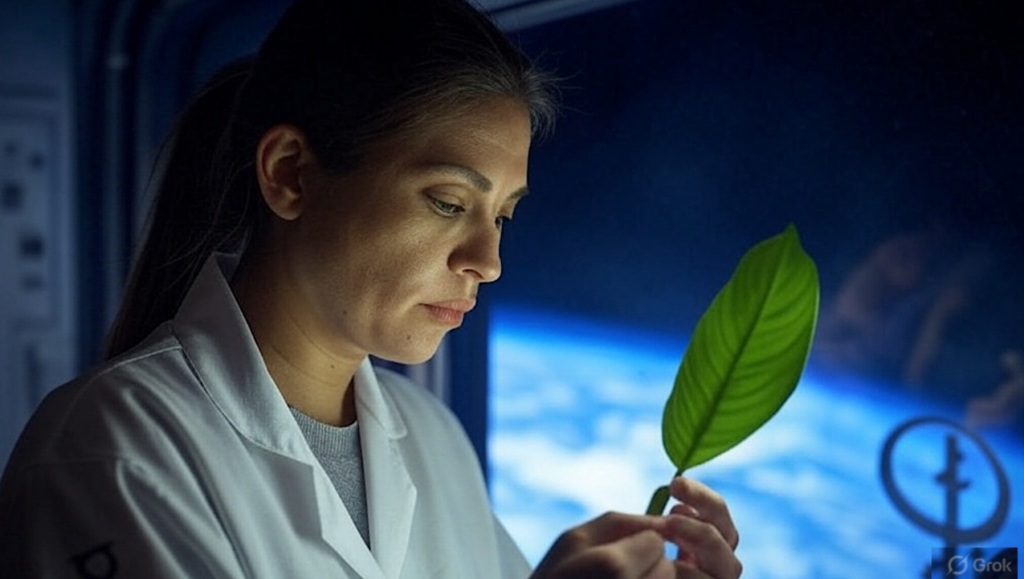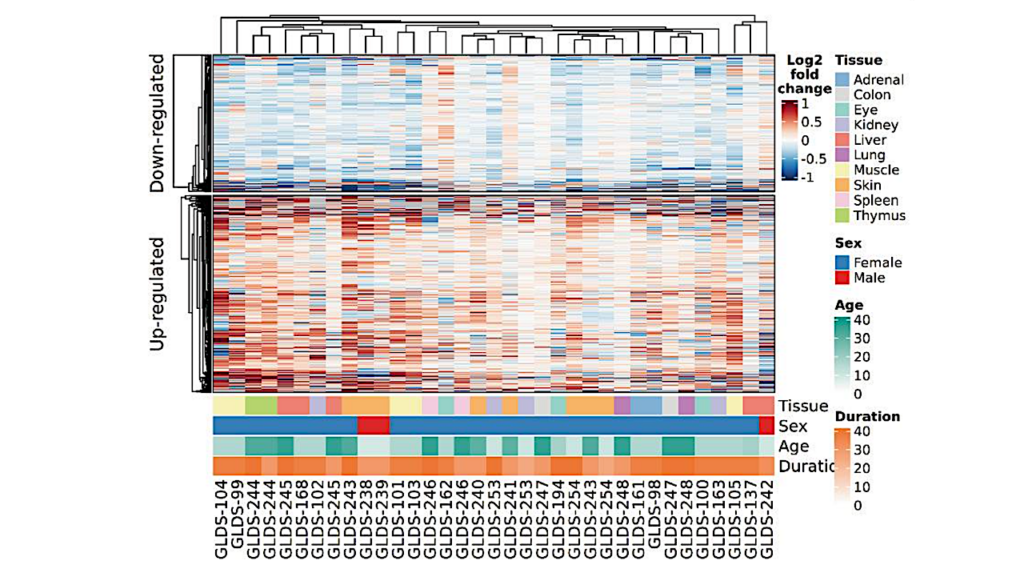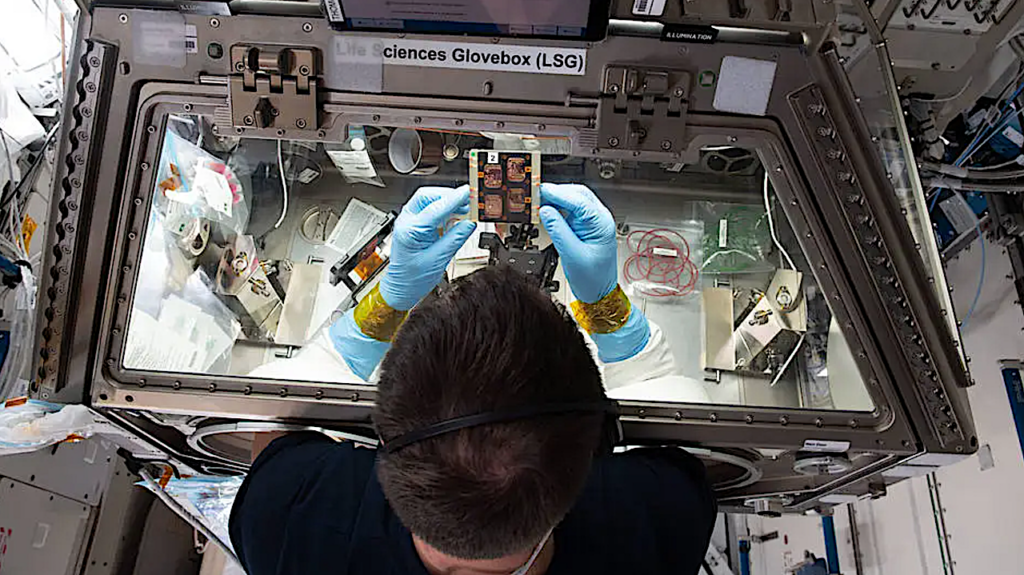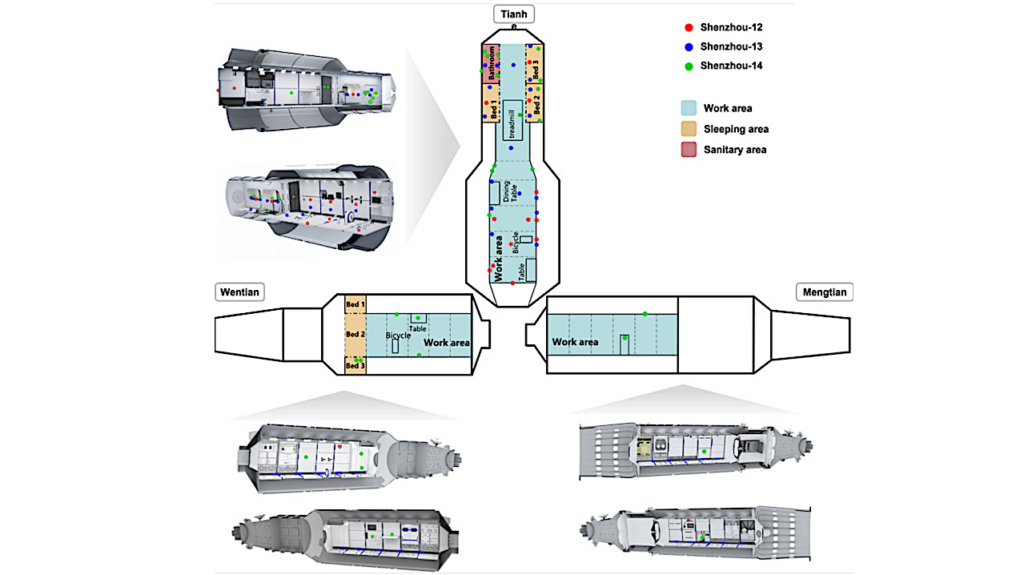NASA Spaceline Current Awareness List #1,142 28 March 2025 (Space Life Science Research Results)

Astrobiology Away Team on Mars — Grok via Astrobiology.com
The abstract in PubMed or at the publisher’s site is linked when available and will open in a new window.
Papers deriving from NASA support:
- Cahill R, Blaber EA, Juran CM, Cheng-Campbell M, Alwood JS, Shirazi-Fard Y, Almeida EAC.37-day microgravity exposure in 16-week female C57BL/6J mice is associated with bone loss specific to weight-bearing skeletal sites.PLoS One. 2025 Mar 26;20(3):e0317307.Note: ISS results. This article may be obtained online without charge.
Journal Impact Factor: Not available for this journal
Funding: “Supported by NASA Space Biology Grant NNH14ZTT001N14-14SF to EACA.” - Roy U, Hadad R, Rodriguez AA, Saju A, Roy D, Gil M, Keane RW, Scott RT, Mao XW, de Rivero Vaccari JP.Effects of spaceflight on inflammasome activation in the brain of mice.Cells. 2025 Mar 12;14(6):417.Note: ISS results. This article may be obtained online without charge.
Journal Impact Factor: 5.1
Funding: “This project was supported by an award from NASA (NASA-MUREP) and UTRGV internal funding to UR.” - Smits E, Reid FE, Tamgue EN, Alvarado Arriaga P, Nguyen C, Britten RA.Sex-dependent changes in risk-taking predisposition of rats following space radiation exposure.Life. 2025 Mar 12;15(3):449.PI: R.A. BrittenNote: This article is part of Section “Astrobiology” (https://www.mdpi.com/journal/life/sections/astrobiology) and may be obtained online without charge.
Journal Impact Factor: 3.2
Funding: “This work was supported by a NASA-HRP IWS Student (E.S. and F.E.R.) supplemental award: NASA grant NNX14AE73G.” - Kamal KY, Trombetta-Lima M.Mechanotransduction and skeletal muscle atrophy: The interplay between focal adhesions and oxidative stress.Int J Mol Sci. 2025 Mar 20;26(6):2802. Review.Note: This article is part of Section “Molecular Biology” (https://www.mdpi.com/journal/ijms/sections/Molecular_Biology) and may be obtained online without charge.
Journal Impact Factor: 4.9
Funding: “K.Y.K. received generous support from NASA EPSCoR (025372-00019) grant awards.” - Thomas SS, Flickinger KL, Elmer J, Callaway CW.Evaluation of non-invasive sensors for monitoring core temperature.J Clin Monit Comput. 2025 Mar 22.PIs: K.L. Flickinger, C.W. CallawayJournal Impact Factor: 2.0
Funding: “This work supported by NASA NNX16AO69A to the Translational Research Institute for Space Health at the Baylor College of Medicine.” - Apodaca BK, Stirling L, Atkins E.Orbital dynamic effects on fuel use in sampling-based plans for proximity operations.J Spacecr Rockets. 2025 Mar 16;1-12.PI: L. StirlingNote: From the abstract: “While proximity operation trajectory planners optimize for fuel cost, robotic sampling-based planners handle complex obstacle fields more robustly. This paper investigates the importance of orbital dynamics in proximity operation paths generated by rapidly exploring random tree for zero-gravity (RRTZ), a sampling-based planner.”
Journal Impact Factor: 1.3
Funding: “This research was supported by NASA Human Research Program Award 80NSSC20K0409.”
Other papers of interest:
- Finch RH, Vitry G, Siew K, Walsh SB, Behesti A, Hardiman G, da Silveira WA.Spaceflight causes strain-dependent gene expression changes in the kidneys of mice.npj Microgravity. 2025 Mar 25;11:11.Note: ISS results. GeneLab is available at https://genelab.nasa.gov. This article may be obtained online without charge.
- Böcker J, Zange J, Siedel T, Fau G, Langner S, Krueger T, Rittweger J.ATHLETIC: An exoskeleton countermeasure exercise device for resistive and plyometric training in deep-space missions.Exp Physiol. 2025 Mar 20. Online ahead of print.Note: This article may be obtained online without charge.
- Bokhari R, Bisson DG, Fortin M, Vigouroux M, Cata JP, Hwang KP, Chen MM, Ceniza-Bordallo G, Ouellet JA, Ingelmo PM.Detrimental effects of spaceflight on the lumbar spine may be correlated to baseline degeneration: Insights from an advanced MRI study.J Pain Res. 2025 Mar 12;18:1375-85.Note: From the article: “We conducted a longitudinal observational case series following the Strengthening the Reporting of Observational Studies in Epidemiology (STROBE) guidelines for observational studies. We include the 2 astronauts after an Axiom Space’s AX-1 commercial spaceflight with 240 orbits and 17 days of duration in the ISS, but analyzing different data that previously published. The data presented here have not been published before.” This article may be obtained online without charge.
- Fan G, Yang H, Zhang Y, Yao M, Wei C, Zhang Q.Research on visual comfort of color matching in space station experiment module.Sci Rep. 2025 Mar 20;15:9553.Note: From the abstract: “Considering the living environment, appropriate color adjustment has a positive effect on improving the visual comfort of astronauts, promoting their physical and mental health, and enhancing work efficiency. This article takes the Chinese space station experimental module as a prototype, and through simulation experiments, uses a method that combines physiological signals with subjective evaluation to compare the differences in the impact of 9 different color matching schemes on human visual comfort.” This article may be obtained online without charge.
- Kumar P, Silvia K, Maney B, Brady MF.A historical review of military support for space capsule rescue and recovery operations.Wilderness & Environmental Medicine. 2025 Mar 28;10806032251322479. Online ahead of print.Note: From the abstract: “The Department of Defense has a long history of supporting the National Aeronautics and Space Administration’s (NASA) crewed missions to space. This includes the recently launched Artemis I, part of the mission that intends to send humans back to the Moon after more than 50 years. Rescue and recovery of astronauts upon splashing down at sea present logistical challenges and may exacerbate specific health concerns related to space travel and extended time spent in microgravity environments. In this article, we explore the evolution of the collaboration between the Department of Defense and NASA, and we describe the role of the US military in supporting NASA as it seeks to send humans to the Moon and beyond.”
- Derobertmasure A, Toh LS, Kafi L, Obeid H, Burk J, Decadi A, Renaud C, Villa-Massone J, Davidson K, kennedy E, Bruno RM, Chhun S, Boutouyrie P.Exploring cardiovascular health and alternative biological fluid sampling methods in extreme environments: Lessons from a 12-day Mars analog mission.Acta Astronaut. 2025 Mar 22. Online ahead of print.Note: From the abstract: “We evaluated arterial stiffness and body composition during a 12-day Mars analog mission at Mars Desert Research Station, Utah. We also explore the feasibility of dried blood spot (DBS) and dried urine spot (DUS) collection.”
- Jasemi S, Simula ER, Yasushi K, Sechi LA.Unveiling the impact of simulated microgravity on HSV-1 infection, neuroinflammation, and endogenous retroviral activation in SH-SY5Y cells.J Neurovirol. 2025 Mar 20.Note: A random positioning machine was used in this study. This article may be obtained online without charge.
- Zhao H, Tu X.The potential key genes within focal adhesion that regulate mesenchymal stem cells osteogenesis or adipogenesis in microgravity related disuse osteoporosis: An integrated analysis.Front Endocrinol (Lausanne). 2025 Mar 9;16:1469400.Note: Hindlimb unloading study. This article may be obtained online without charge.
- Matsakas A, Deane C.From Earth to orbit: How to preserve muscle health in space and bedrest.Exp Physiol. 2025 Mar 26. Online ahead of print.Note: This article may be obtained online without charge.
- Li X, He Y, Han H, Chen Z.Evaluation of shielding materials against galactic cosmic rays for protecting astronauts.Radiat Prot Dosimetry. 2025 Mar 25.Note: From the abstract: “Exposure to Galactic Cosmic Rays (GCR) presents significant health risks to astronauts during long-duration deep space missions. Although existing studies have examined dose and particle energy spectra under GCR exposure scenarios, there is still a lack of studies covering various shielding quantities, especially regarding the self-shielding transmission characteristics of the human body. In this study, we used Monte Carlo simulations with the PHITS codes, coupled with the ICRP male reference phantom, to evaluate the performance of shielding materials against GCR.”
- Breideband L, Wächtershäuser KN, Sarkar R, Puspathasan M, Stelzer EHK, Pampaloni F.Gravitational forces and matrix stiffness modulate the invasiveness of breast cancer cells in bioprinted spheroids.Materials Today Bio. 2025 Apr;31:101640.Note: From the abstract: “The progression of breast cancer is influenced by the stiffness of the extracellular matrix (ECM), which becomes stiffer as cancer advances due to increased collagen IV and laminin secretion by cancer-associated fibroblasts. Intriguingly, breast cancer cells cultivated in two-dimension exhibit a less aggressive behavior when exposed to weightlessness, or microgravity conditions. This study aims to elucidate the interplay between matrix stiffness and microgravity on breast cancer progression.”
- Zhou Y, Xu X, Zhang D.Cognitive load recognition in simulated flight missions: An EEG study.Front Hum Neurosci. 2025 Mar 9;19:1542774.Note: This article is part of Research Topic “Passive Brain-Computer Interfaces: Moving from Lab to Real-World Application” (https://www.frontiersin.org/research-topics/60053/passive-brain-computer-interfaces-moving-from-lab-to-real-world-application/articles) and may be obtained online without charge.
- Fahrion J, Gupta S, Mastroleo F, Dussap CG, Leys N.Chronic low-dose rate irradiation induces transient hormesis effect on cyanobacterium Limnospira indica.iScience. 2025 Mar 21;28(3):111891.Note: This article may be obtained online without charge.
- Markina E, Andreeva E, Buravkova L.Hindlimb unloading reversibly attenuates osteogenic potential of rat skeletal stem and progenitor cells ex vivo.Cells Tissues Organs. 2025 Mar 18;1-20.
- Shulgina SM, Osetsky NY, Rykova MP, Antropova EN, Zhuravleva TV, Shmarov VA, Kutko OV, Vlasova DD, Kotikova AA, Orlova KD, Zhirova EA, Ponomarev SA.Reactivation of latent human intracellular infections during a months-long expedition at the Antarctic Vostok station.Sci Rep. 2025 Mar 22;15(1):9980.Note: From the abstract: “The complex of spaceflight factors has a significant impact on the immunity functional activity. This influence is probably caused by factors such as isolation, monotony, physical inactivity, sensory deprivation, and increased psycho-emotional tension. Long-term wintering at polar stations can be the ground-based model that is most similar to space flight conditions. This research focused on examining the reactivation of latent human pathogens among 11 participants of the 64th Russian Antarctic expedition to Vostok station.” This article may be obtained online without charge.
- Bourdier P, Zahariev A, Rudwill F, Kenny H, O’Gorman DJ, Chery I, Marie-Pierre B, Gauquelin-Koch G, Normand S, Blanc S, Bergouignan A, Simon C.Effect of resistive exercise combined with vibration on body composition and energy balance – Results from the 21-day MNX bedrest study.Acta Astronaut. 2025 Mar 24. Online ahead of print.
- He Z, Zhang B, Ye B, Song Z, Mei Q, Xu J, Zhu H.Effects of neutral postures on mechanical properties of cervical spine under different gravitational environments: A musculoskeletal model study.Life. 2025 Mar 12;15(3):447.Note: This article is part of Special Issue “Feature Paper in Physiology and Pathology: 2nd Edition” (https://www.mdpi.com/journal/life/special_issues/0E97QL71F8) and may be obtained online without charge.
- Kim G, Park H, Kim KS.Low-dose proton induced genetic alteration in cingulate cortex and declined its relevant cognitive function in behaviors.Front Behav Neurosci. 2025;19:1514579.Note: This article is part of Research Topic “Behavioral Impact of Environmental Contaminants: Neurotoxicity and Endocrine Disruption” (https://www.frontiersin.org/research-topics/66669/behavioral-impact-of-environmental-contaminants-neurotoxicity-and-endocrine-disruption/articles) and may be obtained online without charge.
- Rabineau J, Hedge ET, Fournier R, Mastrandrea CJ, Hughson RL.Heart rate variability during exercise can quantify cardiorespiratory deconditioning in 55- to 65-year-old men and women exposed to head-down bedrest.J Appl Physiol (1985). 2025 Mar 18. Online ahead of print.Note: This article may be obtained online without charge.
Astrobiology, Space Biology, Space Life Science, Microgravity, space station,

